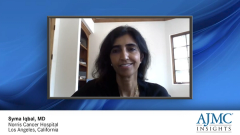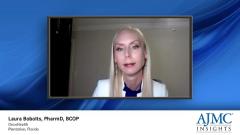
Selecting Optimal Gastroesophageal Treatment: Chemotherapy, Immunotherapy, and Combined Therapies
James M. Cleary, MD, PhD, discusses chemotherapy and immunotherapy as appropriate individual strategies, as well as a combination therapy approach for patients with gastroesophageal cancer.
Episodes in this series

James M. Cleary, MD, PhD: The challenge of immunotherapy is that we’re using the immune system as a weapon to kill off the cancer the same way we’d kill off bacteria. The problem is that we get nervous about giving immunotherapy to patients who already have very active immune systems that attack the cell, patients with autoimmune diseases, such as ulcerative colitis, Crohn disease, or lupus. For patients with significant autoimmune diseases, we think hard before giving them immunotherapy.
Some of the most important [factors] in deciding how you want to treat a patient are their performance status and preferences. Some patients don’t want to get chemotherapy. For my patients with high performance status, my default is to treat them with chemotherapy combined with immunotherapy in the first line. However, for patients who are frail or who don’t want to get chemotherapy, if they have an MSI [microsatellite instability]–high tumor, I’m very comfortable treating them with PD-1–directed therapy by itself without chemotherapy.
We love seeing long responses with PD-1–directed immunotherapy, such as with the patient with gastroesophageal cancer I talked about before who has a 4-year response to PD-1–directed therapy. The other advantage is that PD-1–directed therapy is well tolerated in general. I tell my patients that 90% of patients don’t get a serious autoimmune adverse effect. The chance of getting a serious autoimmune adverse effect from a drug like nivolumab or pembrolizumab is less than 10%. Patients tolerate it very well. Even for frail, older patients, I feel comfortable giving PD-1–directed immunotherapy, especially if there’s a reason why it could do a lot of good, such as having an MSI-high tumor.
The challenge is that in addition to PD-1–directed therapy, another FDA-approved immunotherapy is a CTLA4 antagonist, such as ipilimumab. In squamous cell esophageal cancer, the FDA recently approved ipilimumab, the CTLA4 antibody with nivolumab, the PD-1–directed antibody. Unfortunately, unlike PD-1, CTLA4 antagonists come with a lot of toxicity. When you’re combining PD-1 and CTLA4 inhibition with regimens such as ipilimumab and nivolumab, it comes with a significant amount of autoimmune toxicity. This isn’t easy. Because of that extra toxicity, I think long and hard before I give a regimen like that. I haven’t been using ipilimumab-nivolumab in squamous cell esophageal cancer because I haven’t found a patient population that merits it.
I typically treat HER2 [human epidermal growth factor receptor 2]–negative patients with FOLFOX [5-fluorouracil, leucovorin, oxaliplatin]–nivolumab in the first line. Upon progression in the second-line setting, I treat them with paclitaxel and ramucirumab. If they still have a good performance status in the third-line setting, I’ll typically use TAS-102 [tipiracil hydrochloride]. I love to put patients on clinical trials, especially in the second- and third-line settings, because we wish our second- and third-line setting therapies were better. That’s a great spot to try a clinical trial. For my HER2-amplified patients, I typically start with FOLFOX [5-fluorouracil, leucovorin, oxaliplatin], trastuzumab, and pembrolizumab. In the second-line setting, I’ll use Enhertu [trastuzumab deruxtecan]. In the third-line setting, there are a lot of options. But if the patient still a good performance status, I might try paclitaxel and ramucirumab, and then you have TAS-102 [tipiracil hydrochloride] as well.
There’s a question in the field: how are patients with gastroesophageal cancer going to tolerate immunotherapy? Is it different from the tolerance seen in other cancers? The good news is that it isn’t different. Patients with gastroesophageal cancer tolerate PD-1–directed immunotherapy just as well as patients with melanoma and lung cancer. That’s good news because it’s well tolerated. Ninety percent of patients who get PD-1–directed therapy don’t get a serious autoimmune adverse effect. Less than 10% of patients get it. The good news is that our gastroesophageal cancer population tolerates PD-1–directed therapy very well.
Transcript edited for clarity.
Newsletter
Stay ahead of policy, cost, and value—subscribe to AJMC for expert insights at the intersection of clinical care and health economics.










































